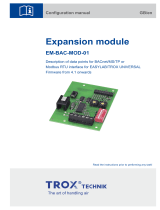
1
www.analogway.com
LIVEPREMIER™ AWJ PROTOCOL
Table of contents
1. Presentation ................................................................................................................................................ 3
1.1. Description .................................................................................................................................................... 3
1.2. Syntax ............................................................................................................................................................ 3
1.3. Error messages .............................................................................................................................................. 4
1.4. Subscribing to machine state change notifications ...................................................................................... 4
2. System commands ...................................................................................................................................... 6
2.1. Reading the device type ................................................................................................................................ 6
2.2. Reading the device serial number ................................................................................................................. 6
2.3. Reading the device firmware version ........................................................................................................... 7
2.4. Restarting the device .................................................................................................................................... 7
2.5. Shutting down the device (switch off) .......................................................................................................... 7
3. Screen/Auxiliary Screen commands ........................................................................................................... 8
3.1. TAKE: Transitioning a Preview content to the Program................................................................................ 8
3.2. Recalling a Screen Preset .............................................................................................................................. 8
3.3. Recalling a Master Preset .............................................................................................................................. 9
3.4. Reading Preset information .......................................................................................................................... 9
3.5. Changing the source in a layer .................................................................................................................... 10
3.6. Changing screen background source .......................................................................................................... 11
3.7. Reading the last loaded preset ................................................................................................................... 12
3.8. Reading the last loaded master preset ....................................................................................................... 12
3.9. Changing routing audio source ................................................................................................................... 13
4. Multiviewer commands ............................................................................................................................ 14
4.1. Recalling a Multiviewer Preset .................................................................................................................... 14
4.2. Changing multiviewer widget source .......................................................................................................... 14
5. Using thumbnails ...................................................................................................................................... 15
5.1. Introduction ................................................................................................................................................ 15
5.2. Live inputs thumbnails URL ......................................................................................................................... 15
5.3. Still Images thumbnails URL (does not work for timers thumbnails) ......................................................... 15
5.4. Outputs thumbnails URL ............................................................................................................................. 15
5.5. Multiviewer thumbnails URL ....................................................................................................................... 15
5.6. Timers thumbnails URL ............................................................................................................................... 15
6. Waking the LivePremier™ device (over LAN) ....................................................................................... 16
6.1. Description .................................................................................................................................................. 16
6.2. Wake on LAN and Magic Packet ................................................................................................................. 16



















